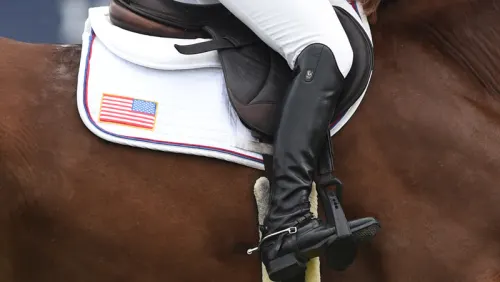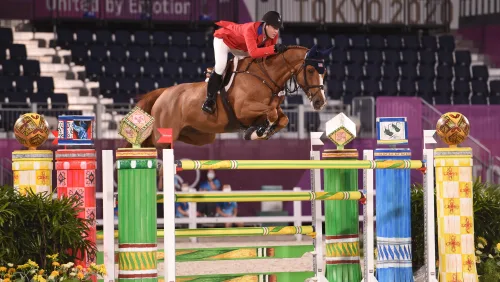Our columnist recalls his first trainer and mentor, his “spiritual father.”
Gordon Wright was born in 1903. He and my mother remarked that their birthdays were close together, and she was born on March 7, 1903. Wright was not his real name. I suppose he changed it to Wright because usually Gordon was RIGHT. Gordon was one of the smartest, if not the smartest, man I have ever known—not only about horses but also about life in general.
Gordon was from Utah, and like Jimmy Williams, Gordon had a good, practical dose of “cowboy” in him as a horseman. All really good horsemen have a bit of cowboy.
In 1927, so the story goes, Gordon came to ride in the rodeo at Madison Square Garden. Being the smart man that he was, he realized that cowboys got hurt a lot. He also realized that English riding, hunting and showing was becoming more and more popular as a leisure sport and activity. He decided to stay east and opened up a stable in Westchester County, N.Y., which he called Saxon Woods.
I gather that Gordon had enough success showing and teaching in the New York metropolitan area during the 1930s and had a sizeable clientele. He had notable success on an open jumper named Sonny. Bill Steinkraus, Elaine Moore (his step-daughter), Elizabeth Hyland (Molony), Anne Morningstar, and Nancy, Archie and Hugh Dean were all early students of his who won the Maclay Finals in the 1930s through mid-1940s.
During the 1930s, Gordon, it seems, was mostly self taught, although he did tell me he would drive to West Point once a week to take lessons with Colonel “Gyp” Wofford, Jimmy Wofford’s father. Wofford would say: “Wright, get your heels down and come back next week!” Gordon would come back the next week and get the same instruction!
The Educator’s Education
The “Forward Seat” was just starting to come into civilian fashion during the 1930s, so I’m sure Gordon, as well as his friend Capt. Vladimir Littauer, were exposed to it. However Gordon wasn’t formally educated in this Italian-French based system until his Fort Riley years.
ADVERTISEMENT
Gordon married Jackie Moore in 1940. Jackie was an author of some renown from New York City. She had two daughters, Elaine and Pamela. Elaine went on to become a top rider, flirting with being on our USET team, and Pamela became the “Francoise Sagan” of America, writing Chocolates For Breakfast, a novel which became an overnight sensation.
Gordon became the oldest guy to enlist in Fort Riley during the early 1940s. That was where Gordon was formally educated as a rider and teacher. For the rest of his life, Gordon had bouts of malaria, which he picked up in the Pacific during the war.
When Gordon got out of the service, he went back to New York and opened a stable called Secor Farms on Hillair Circle in White Plains. Frank and Wayne Carroll worked closely with him there for years, and so did Dave Rose.
As a young child of 10 or 11, I’d already heard of this man from some of my older friends at the Ox Ridge Hunt Club: Mary Gay Hofford, Glenna Lee Maduro, Ronnie Mutch, Victor Hugo-Vidal, etc. These more advanced riders would “sneak” down to Gordon, considered the premier teacher in America at the time, for lessons. Of course Miss V. Felicia Townsend and Otto Heuckeroth, the teachers at Ox Ridge, knew what was happening, but it was all “on the Q.T.” Eventually though, even Miss Townsend would go down to watch and learn from Gordon.
White Plains was a half hour drive down the Merritt Parkway from New Canaan and Darien, Conn., where I lived and rode. However at 11 years old late in 1949, having been overfaced, I’d totally lost confidence. Glenna Lee Maduro’s mother suggested to my mother that she take me down to Gordon for lessons. I even remember her giving my mother directions.
Secor Farms was no Ox Ridge Hunt Club as far as a facility or stable management was concerned. However you had Gordon, who was a technical master. Secor had three levels of stables: the dungeon (basement), ring-level stalls, and then the penthouse for the show horses. The indoor ring was dirt (dust) and a bit of an odd shape right next to the road. Gordon had access to a field across the road where we schooled over an outside course.
My first lesson with Gordon was on Silver King, a dead-quiet palomino school horse. I am sure he had foundered. He certainly didn’t want to go anywhere. Gordon put me in position at a standstill, and we worked at a walk and trot. Any jumping would have only been over crossrails. Of course my confidence leapt forward. I was learning what I was doing, and everything was low and slow.
This was Gordon’s style: explanation, demonstration, application, correction, repetition. He didn’t let you go faster or higher until you’d mastered all the basic teachings. He put the best foundation on a rider of any teacher I’ve ever seen—before or since. Gordon was a genius with adults who have more apprehension.
ADVERTISEMENT
Gordon was a powerful presence at the horse shows. Like few teachers since, his riders had all the divisions covered: hunters, jumpers and equitation. He was equally comfortable working with a novice equitation rider, a timid adult hunter rider, or a U.S. team prospect in the jumper division.
A Genius And A Giant
Fifty years ago there was more prejudice, and social position was more important than it is today. Some people might have looked down on Gordon because of his background. He wasn’t “of the manor born.” However, everybody liked, or even loved, Gordon. He was especially popular with his professional horsemen. And the rich and famous flocked to him for lessons: Nancy Maginnes (Kissinger), Gussie Busch, Ethel Skakel (Kennedy) and C.Z. Guest to name just a few.
Gordon was the sharpest of businessmen. He died a very wealthy man. Victor Hugo-Vidal Jr. and I would ride in the 11 a.m. class with about six other people. We’d all pay for the lesson. If we were on other clients’ young horses, they would also pay for their horse to be in the lesson. Around 12:30 p.m., we’d all go upstairs to the lounge where we paid for lunch and drinks. Believe me the barn at Secor did a lot of business in those days. After lunch Victor and I would go back to the ring to school colts. The owners paid again. Meanwhile Gordon stayed upstairs playing bridge, gin rummy and other games for money. Gordon rarely lost.
Gordon was a teacher’s teacher. He taught us all to teach as he taught us to ride. He told my father not to let me go into the horse business unless I learned how to teach. He took me with him to give clinics in Atlanta and set up my first clinics in Texas.
Gordon was a social animal in a very low-key way. He loved women, barbecuing a steak and a cocktail. He loved showing his horse movies. Gordon not only loved riding and showing, but he was also an avid foxhunter. In fact, he was master of his own hunt in the Carolinas. However, at the end of the day Gordon was an educator.
As far as basics are concerned, Gordon Wright was the man most responsible in this country for our style, system and method. Much of what we see today in the horse show world and the eventing world can be traced back to Gordon Wright and his Fort Riley schooling.
Personally I owe him a life, a passion and a career, as do many others. Gordon was a genius and a giant. He was my spiritual father.
George Morris has ridden for almost 70 years, and he’s been an international competitor and trainer for 55 years. He served as the U.S. show jumping chef d’equipe from 2004-2012 and was the assistant chef d’equipe starting in 1980. He has been a Chronicle columnist since 1980 and a subscriber since the 1940s.















